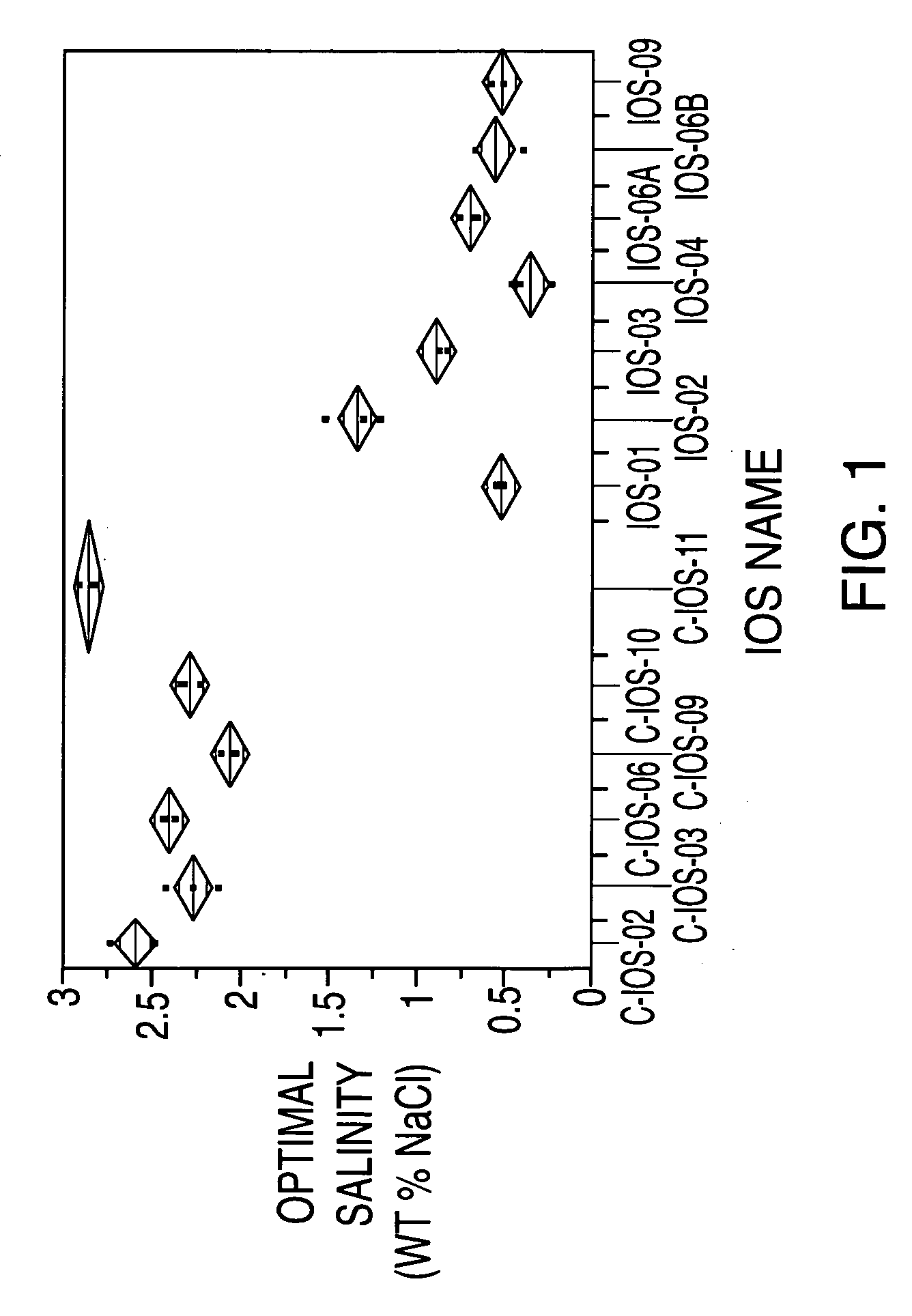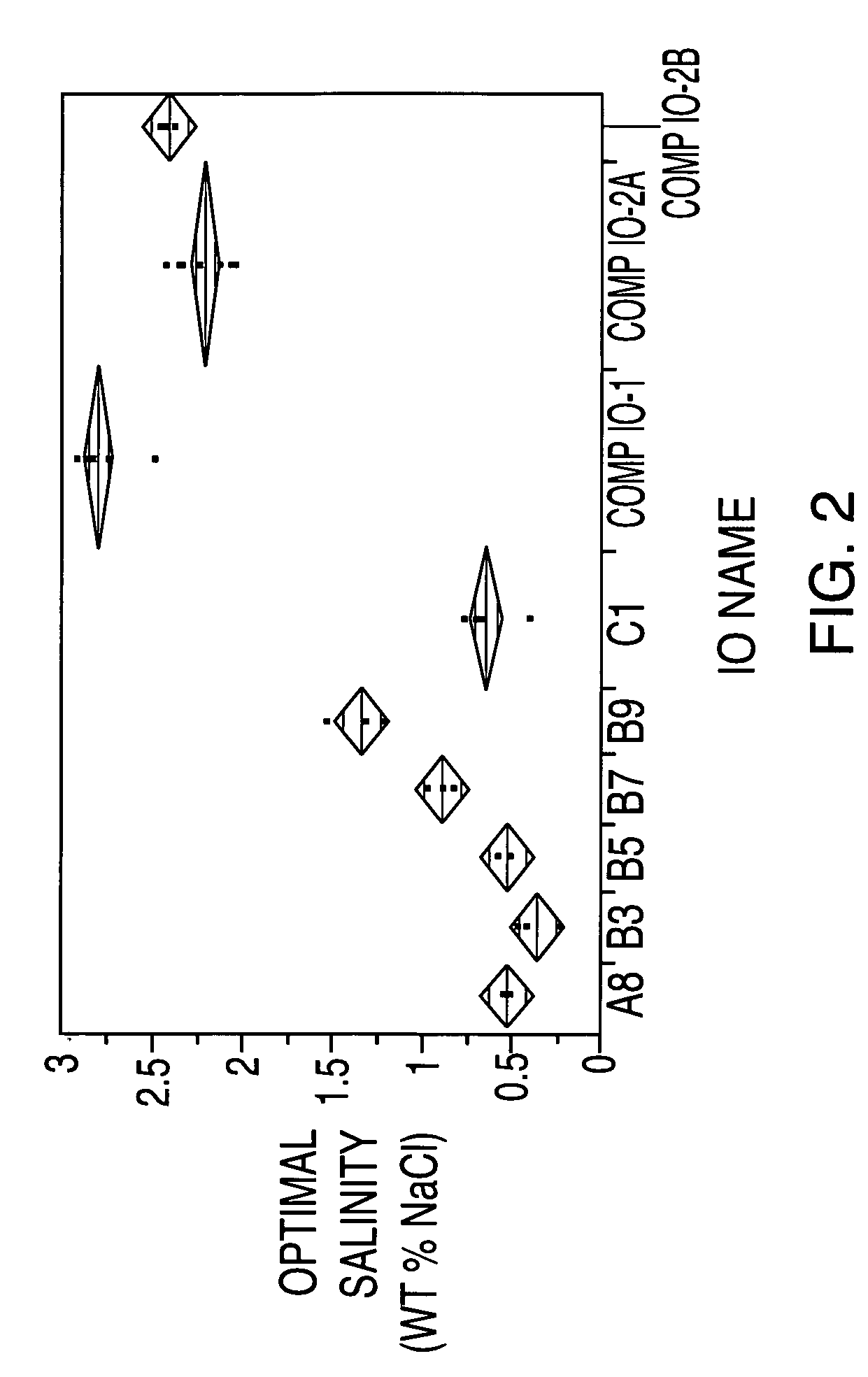Sulfonated internal olefin surfactant for enhanced oil recovery
- Summary
- Abstract
- Description
- Claims
- Application Information
AI Technical Summary
Benefits of technology
Problems solved by technology
Method used
Image
Examples
example 1
General Metathesis Procedure A
[0145]A mixture of 1-decene (0.2 moles, NAO 10 from Chevron Phillips Chemical Company), 1-dodecene (0.2 moles, NAO 12 from Chevron Phillips Chemical Company) and 1-tetradecene (0.2 moles, NAO 14 from Chevron Phillips Chemical Company) was placed into a 250 mL four-necked reaction flask equipped with a thermocouple, a magnetic stirbar, a reflux condenser, and rubber septa in the remaining neck. A syringe needle (18 gauge) was inserted through one of the septa and submerged in the liquid. The needle was attached to a nitrogen source and nitrogen was gently bubbled through the liquid. The nitrogen was vented through the condenser into a glycerin filled bubbler. The liquid was heated to temperature and was degassed for 0.5 hour at 60° C. or 1 hour at 30° C. (see Table 1) with a constant subsurface flow of nitrogen. Afterwards, 100 mole ppm (based on total moles of olefin employed) of metathesis catalyst (see Table 1) was added by removing the thermocouple a...
example 2
General Metathesis Procedure B for the Synthesis of Internal Olefins (IO) with Ruthenium Catalyst 12
[0146]Standard inert atmosphere techniques were employed throughout the metathesis reaction in order to minimize any effects of oxygen on the reaction. The desired alpha-olefin or alpha-olefin mixture (C10: 1-decene, C12: 1-dodecene, C14: 1-tetradecene, or mixtures thereof, obtained from CP Chem, The Woodlands, Tex.) was charged to a 1 L four-necked reaction flask equipped with a thermocouple, magnetic stir-bar, reflux condenser, and rubber septa in each of the remaining two necks and heated to 50° C. Addition of a ruthenium-based metathesis catalyst 12 (obtained from Sigma-Aldrich, Inc; Milwaukee, Wis.; Catalog #579726) (ca 0.0.02-0.25 mole %) initiated the reaction. After achieving an olefin conversion of greater than 95% as determined by 1HNMR spectroscopy, heating was discontinued and the reaction sparged with air. Filtration through silica gel removed the spent catalyst from the ...
example 3
Metathesis Procedure C for the Scale-Up Synthesis of Internal Olefins with Ruthenium Catalyst C831
[0147]The starting material was passed through an activated alumina column and loaded into a 50 gallon reactor. The reactor was evacuated by mechanical vacuum pump (with outgassing vented through a fume hood) and refilled with argon or nitrogen three times. Catalyst (0.00005 equiv.) was added as a solid through the reactor port under a positive pressure of nitrogen. The reactor was closed, and the solution was stirred under vacuum. After several minutes, vigorous foaming began. The process was run in two stages. In stage one (2-3 h), the temperature was set at 20° C. and full vacuum was applied. In stage two (17-23 h), the temperature was increased to 30° C. and vacuum was accompanied by sparging N2 (diverted from a bubbler) through a dip tube. The reaction was monitored by GC at the completion of stage one, two hours into stage two, and at the reaction end point. Monitoring was accompl...
PUM
| Property | Measurement | Unit |
|---|---|---|
| Mass | aaaaa | aaaaa |
| Molar density | aaaaa | aaaaa |
| Fraction | aaaaa | aaaaa |
Abstract
Description
Claims
Application Information
 Login to View More
Login to View More - R&D
- Intellectual Property
- Life Sciences
- Materials
- Tech Scout
- Unparalleled Data Quality
- Higher Quality Content
- 60% Fewer Hallucinations
Browse by: Latest US Patents, China's latest patents, Technical Efficacy Thesaurus, Application Domain, Technology Topic, Popular Technical Reports.
© 2025 PatSnap. All rights reserved.Legal|Privacy policy|Modern Slavery Act Transparency Statement|Sitemap|About US| Contact US: help@patsnap.com



